The F-style Jugs Market is estimated to be valued at USD 172.9 billion in 2025 and is projected to reach USD 268.5 billion by 2035, registering a compound annual growth rate (CAGR) of 4.5% over the forecast period.
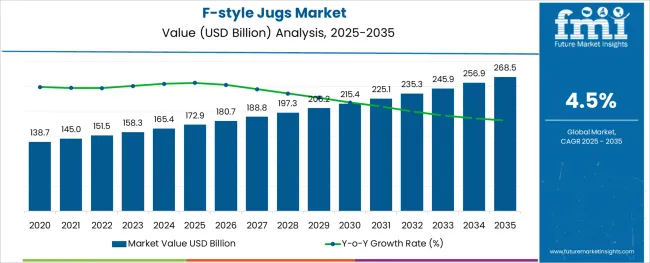
The F-style jugs market is expanding steadily due to the increasing demand for durable and chemical-resistant containers across various industries. Growing industrial activities and the need for safe storage and transportation of chemicals and fertilizers have heightened the importance of robust packaging solutions. Material advancements have improved the strength and chemical compatibility of containers, making them more reliable for hazardous substances.
Rising regulatory focus on packaging safety and environmental compliance has encouraged the adoption of high-quality materials such as polyethylene. Additionally, larger capacity containers are preferred for bulk handling, which supports operational efficiency.
The market outlook remains positive as manufacturers innovate to meet evolving customer needs while complying with environmental standards. Segmental growth is expected to be led by polyethylene as the preferred material, containers with capacity above 500 ml, and the chemical and fertilizers sector as the primary end use.
The market is segmented by Material, Capacity, and End Use and region. By Material, the market is divided into Polyethylene (PE), Polypropylene (PP), and Polyethylene Terephthalate (PET). In terms of Capacity, the market is classified into Above 500 ML, Less than 100 ML, and 100-500 ML.
Based on End Use, the market is segmented into Chemical & Fertilizers, Food & Beverage, Automotive, Oil & Lubricants, and Agriculture. Regionally, the market is classified into North America, Latin America, Western Europe, Eastern Europe, Balkan & Baltic Countries, Russia & Belarus, Central Asia, East Asia, South Asia & Pacific, and the Middle East & Africa.
The market is segmented by Material, Capacity, and End Use and region. By Material, the market is divided into Polyethylene (PE), Polypropylene (PP), and Polyethylene Terephthalate (PET). In terms of Capacity, the market is classified into Above 500 ML, Less than 100 ML, and 100-500 ML.
Based on End Use, the market is segmented into Chemical & Fertilizers, Food & Beverage, Automotive, Oil & Lubricants, and Agriculture. Regionally, the market is classified into North America, Latin America, Western Europe, Eastern Europe, Balkan & Baltic Countries, Russia & Belarus, Central Asia, East Asia, South Asia & Pacific, and the Middle East & Africa.
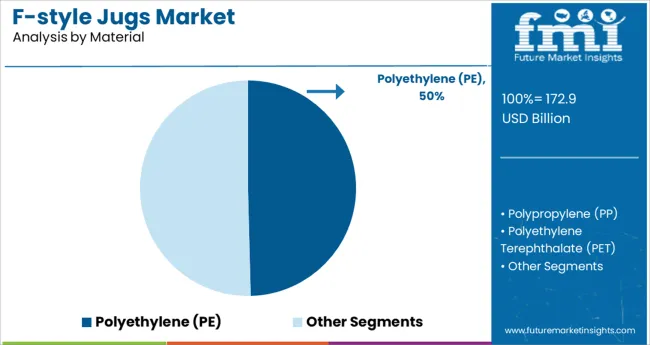
Polyethylene (PE) dominates the material segment with a 49.6% market share in 2025. This preference is driven by polyethylene’s excellent chemical resistance, durability, and cost-effectiveness. It offers reliable protection against corrosion and leakage, which is essential for storing aggressive chemicals and fertilizers.
The versatility of polyethylene in molding complex shapes also enables ergonomic jug designs suitable for industrial handling. Its lightweight nature reduces transportation costs and improves ease of use.
Additionally, polyethylene is recyclable, which aligns with increasing environmental regulations and corporate sustainability goals. These factors collectively ensure the continued preference for polyethylene in the F-style jugs market.
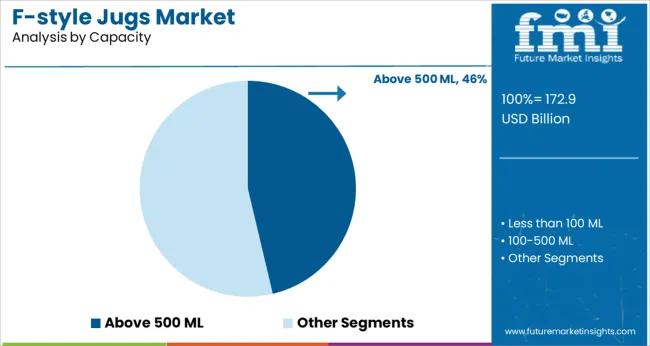
The capacity segment featuring containers above 500 ml is expected to capture 46.3% of the market revenue in 2025. This segment benefits from the operational advantages of larger containers in industrial and agricultural applications. Bulk storage reduces the frequency of refills, streamlines logistics, and improves handling efficiency.
Many chemical and fertilizer products require storage in volumes exceeding 500 ml to meet application demands, making this segment highly relevant. Additionally, larger containers often include features for safe pouring and handling, which enhance user convenience.
The growing scale of agricultural and industrial operations further supports demand in this capacity range.
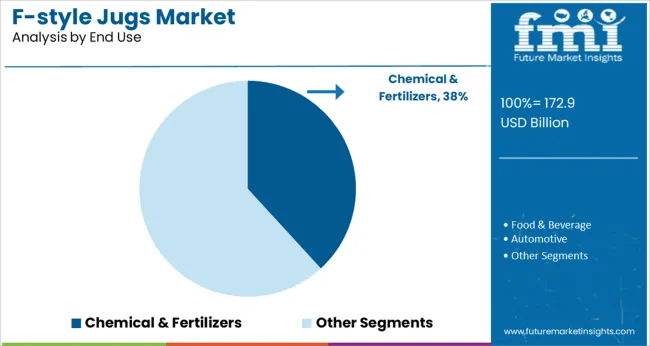
The Chemical & Fertilizers sector holds 38.2% of the F-style jugs market revenue in 2025, establishing it as the leading end-use segment. This growth has been driven by the need for specialized containers that safely store and transport a variety of chemicals, including pesticides, herbicides, and liquid fertilizers.
Safety regulations require containers that can resist chemical degradation and prevent leaks, which has increased reliance on high-performance jugs. The expanding agricultural sector and increasing use of chemical fertilizers to enhance crop yields have also contributed to market growth.
The segment benefits from ongoing investments in industrial packaging technology and heightened awareness around safe chemical handling. Demand for reliable, compliant containers is expected to continue driving this segment’s growth.
Demand for F-style jugs is surging at a rapid pace across the chemical industry. The rapid adoption of these containers for packaging and storing processes foods and liquid products such as edible oil, sauces, jam, purees, juices, and others is accelerating sales across the food & beverage industry. Increasing customer demand for easy-to-use, stack, and store packaging products is catapulting the sales of F-style jugs across diverse industries.
Industry players are increasingly focusing on adopting robust packaging solutions to extend the shelf life and minimize product wastage while pouring activities. As F-style jugs fulfill these requirements along with providing additional benefits such as chemical resistance and low risk of leakage, demand for these containers is propelling in the market.
Over the past couple of years, a swift rise in the adoption of sustainable and recyclable packaging solutions is being witnessed across diverse industries, owing to rising environmental concerns and the implementation of stringent regulations in countries such as the USA, China, India, the United Kingdom, and others.
As F-style jugs are reusable and are made of environment-friendly & recyclable material such as HDPE plastic, they are gaining huge popularity across the food & beverage and chemical industries. This is anticipated to elevate the demand for F-style jugs in the global market.
Plastics such as high-density polyethylene, polypropylene, polyethylene terephthalate, and others take hundreds of years to decompose. Thus, governments in several countries are implementing several guidelines and regulations for declining the use of plastics for packaging. This is restraining the demand for F-style jugs in the global market.
In addition to this, the high cost of these containers and the increasing use of metal cans for lubrication and petroleum products is expected to hinder the sales of F-style jugs.
FMI states that Asia Pacific excluding Japan is estimated to account for the maximum revenue share in the global F-style jugs market from 2025 to 2035.
Rising customer inclination towards deep-fried food products such as potato chips, fries, snacks, patties, and others has resulted in augmenting the demand for edible oils such as sunflower oil, soybean oil, and groundnut oil among others.
Thus, key industry players are increasingly aiming at expanding their oil production capacity to cater to this growing demand. For instance, in 2025, Fortune Oil, an Indian edible oil-producing company announced its plan of investing USD 59.5 Million for acquiring small regional enterprises to expand its vegetable oil production capacity. As F-style jugs are extensively used for packaging edible oil in 2 liters, 5 liters, 10 liters, and 15 liters capacities, such developments are projected to bolster sales in the Asia Pacific excluding the Japan market.
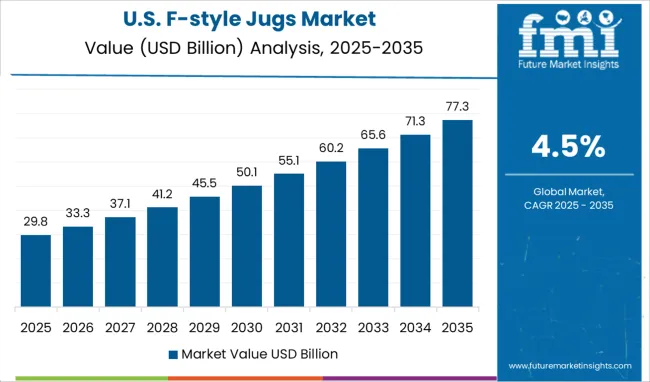
As per Future Market Insights, North America is anticipated to exhibit healthy growth in the global F-style jugs market during the forecast period 2025 to 2035.
Increasing adoption of sustainable and durable packaging solutions in various industries such as automotive, chemical, fertilizer, and others is augmenting the demand for F-style jugs. With growing applications across homecare products across countries such as the USA and Canada, leading players are aiming at launching novel products with safety features.
For instance, in 2020, CSBD LLC., an American manufacturer of plastic packaging products announced launching a new F-Style Clear Plastic Jug with leakage-proof, child-resistant closure for residential and industrial cleaning products application. A slew of such new product launches is estimated to favor growth in the North American market.
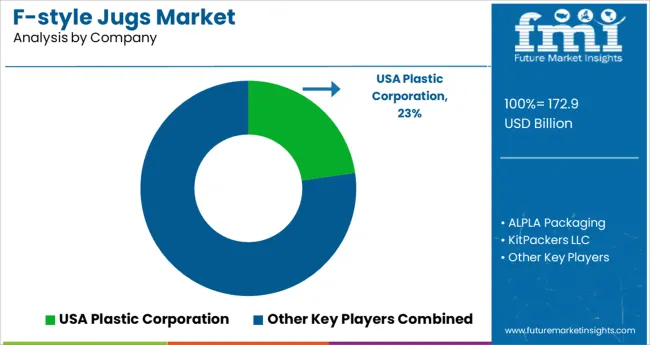
Some of the leading players in the global F-style jugs market are USA Plastic Corporation, CSBD LLC., Berlin Packaging, Polycon Industries, Inc., Qorpak, MJS Packaging, LPS Industries, Berk Company, LLC, Pretium Packaging Solutions, CKS Packaging, Inc., Comar, LLC., and others.
Key players in the F-style jugs market are focusing on launching novel products and capacity expansion to strengthen their footprint in the highly competitive market.
| Report Attribute | Details |
|---|---|
| Growth Rate | CAGR of 4% to 5% from 2025 to 2035 |
| Base Year for Estimation | 2024 |
| Historical Data | 2020 to 2024 |
| Forecast Period | 2025 to 2035 |
| Quantitative Units | Revenue in million and CAGR from 2025 to 2035 |
| Report Coverage | Revenue Forecast, Volume Forecast, Company Ranking, Competitive Landscape, Growth Factors, Trends, and Pricing Analysis |
| Segments Covered | Material Type, Capacity, Application, End Use, Region |
| Regions Covered | North America; Latin America; Western Europe; Eastern Europe; Asia Pacific excluding Japan; Japan; Middle East and Africa |
| Key Companies Profiled | USA Plastic Corporation; CSBD LLC.; Berlin Packaging; Polycon Industries, Inc.; Qorpak; MJS Packaging; LPS Industries; Berk Company, LLC; Pretium Packaging Solutions; CKS Packaging, Inc.; Comar, LLC |
| Customization | Available Upon Request |
The global f-style jugs market is estimated to be valued at USD 172.9 billion in 2025.
It is projected to reach USD 268.5 billion by 2035.
The market is expected to grow at a 4.5% CAGR between 2025 and 2035.
The key product types are polyethylene (pe), polypropylene (pp) and polyethylene terephthalate (pet).
above 500 ml segment is expected to dominate with a 46.3% industry share in 2025.






Full Research Suite comprises of:
Market outlook & trends analysis
Interviews & case studies
Strategic recommendations
Vendor profiles & capabilities analysis
5-year forecasts
8 regions and 60+ country-level data splits
Market segment data splits
12 months of continuous data updates
DELIVERED AS:
PDF EXCEL ONLINE
Industrial Jugs Market

Thank you!
You will receive an email from our Business Development Manager. Please be sure to check your SPAM/JUNK folder too.
Chat With
MaRIA